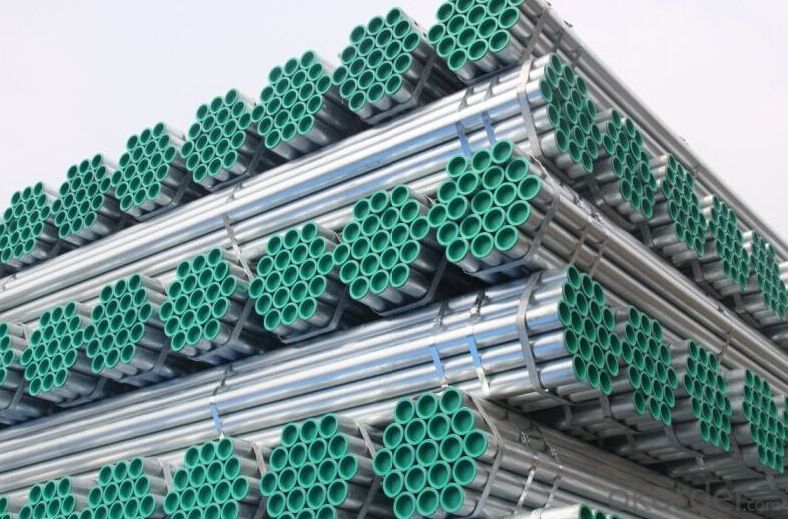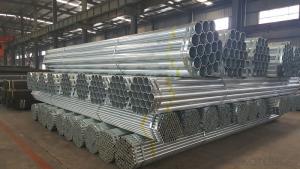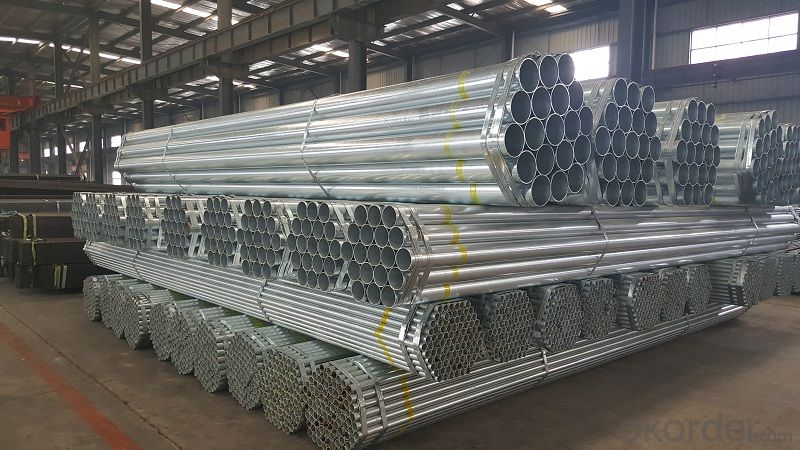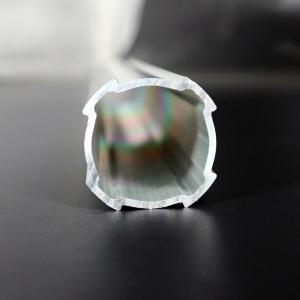Rectangular Galvanized Steel Pipes for Mining and Metallurgy Welding
- Loading Port:
- Shanghai
- Payment Terms:
- TT OR LC
- Min Order Qty:
- 15 m.t.
- Supply Capability:
- 12000 m.t./month
OKorder Service Pledge
OKorder Financial Service
You Might Also Like
Specification
1、Structure of Welding of galvanized steel pipes for mining and metallurgy
The surface of galvanized steel pipe welded steel pipe of hot dip galvanized layer or. Galvanized can increase the corrosion resistance of the steel tube, prolong service life. Galvanized pipe is widely used, in addition to water, gas, oil and other general low pressure fluid pipelines. It is also used in the petroleum industry, especially for offshore oil field of oil well pipe and oil pipe, chemical, coking equipment of oil heater, condensation cooler, coal run oil exchanger tube, and trestle pile, the mine tunnel support frame tube.
2、Main Features of Welding of galvanized steel pipes for mining and metallurgy
• High manufacturing accuracy
• High strength
• Good visual effect
• Reasonable price
3、 Welding of galvanized steel pipes for mining and metallurgy Specification:
Standard | GB, DIN, ASTM ASTM A106-2006, ASTM A53-2007 |
Grade | 10#-45#, 16Mn 10#, 20#, 45#, 16Mn |
Thickness | 1 - 33 mm |
Section Shape | Round |
Outer Diameter | 21 - 610mm |
Place of Origin | Tianjin, China (Mainland) |
Secondary Or Not | Non-secondary |
Application | Hydraulic Pipe |
Technique | Cold Drawn |
Certification | API |
Surface Treatment | factory state or painted black |
Special Pipe | API Pipe |
Alloy Or Not | Non-alloy |
Length | 5-12M |
Outer Diameter | 21.3-610mm |
Grade | 20#, 45#, Q345, API J55, API K55, API L80, API N80, API P110, A53B |
Standard | ASME, ASTM |
1) Material:Q195 Q235 Q345 X42 X52
2) Specification range:OD:21.3-610mm,WT:6-70mm,length:6-12m or according to the requirement of clients.
3) Excutive standards:GB,ASME API5L.ASTM A 106/A53,Despite of the above standards,we can also supply seamless steel pipe with standard of DIN,JIS,and so on,and also develop new products according to the requirements of our clients!
4) Surface: galvanized.
5) Ends:Beveled or square cut,plastic capped,painted.
6) Packing:bundles wrapped with strong steel strip,seaworthy packing.
4、Packaging & Delivery
Packaging Details: | seaworthy package,bundles wrapped with strong steel strip |
Delivery Detail: | 15-30days after received 30%TT |
5、FAQ of Welding of galvanized steel pipes for mining and metallurgy
:
①How is the quality of your products?
Our products are manufactured strictly according to national and internaional standard, and we take a test
on every pipe before delivered out. If you want see our quality certifications and all kinds of testing report, please just ask us for it.
Guaranteed: If products’ quality don’t accord to discription as we give or the promise before you place order, we promise 100% refund.
②How about price?
Yes, we are factory and be able to give you lowest price below market one, and we have a policy that “ for saving time and absolutely honest business attitude, we quote as lowest as possible for any customer, and discount can be given according to quantity”,if you like bargain and factory price is not low enough as you think, just don’t waste your time.Please trust the quotation we would give you, it is professional one.
③Why should you chose us?
Chose happens because of quality, then price, We can give you both.Additionally, we can also offer professional products inquiry, products knowledge train(for agents), smooth goods delivery, exellent customer solution proposals.Our service formula: good quality+good price+good service=customer’s trust
SGS test is available, customer inspection before shipping is welcome, third party inspection is no problem.
6、 Welding of galvanized steel pipes for mining and metallurgy Images:


- Q:How are steel pipes protected against mechanical damage during transportation?
- Steel pipes are protected against mechanical damage during transportation through various measures. One common method is the use of protective coating or wrapping materials. These coatings are usually made of materials like plastic, rubber, or epoxy, which provide a physical barrier to protect the pipes from scratches, dents, or other forms of mechanical damage. Another method is the use of padding or cushioning materials such as foam inserts or rubber gaskets. These materials are placed inside the pipes or around them to absorb any impact or shock during transportation. This helps prevent any potential damage caused by bumps or vibrations. In addition, steel pipes are often secured and immobilized within transportation containers using straps, braces, or other securing devices. These measures ensure that the pipes remain stable and do not move or collide with each other, reducing the risk of mechanical damage. Furthermore, proper handling and loading techniques are crucial in protecting steel pipes during transportation. This includes using appropriate lifting equipment, such as cranes or forklifts, to avoid dropping or mishandling the pipes. Additionally, pipes are often stored or stacked in a way that minimizes the risk of deformation or bending. Overall, a combination of protective coatings, cushioning materials, securement devices, and proper handling techniques are employed to safeguard steel pipes against mechanical damage during transportation. These measures help ensure that the pipes arrive at their destination in optimal condition, ready for use in various applications.
- Q:Is it good to buy a simple wardrobe or a steel pipe?
- Therefore, the simple solid wood wardrobe and steel pipe wardrobe is good or bad, according to personal preferences to set, and that environmental protection seems to have grades, easy to crack
- Q:How are steel pipes stored and transported?
- Steel pipes are typically stored and transported in a systematic and efficient manner to ensure their safety and prevent damage. When it comes to storage, steel pipes are usually stacked horizontally or vertically in designated areas. If stacked vertically, they are often placed on custom-made racks or stands that provide support and prevent them from rolling or collapsing. This vertical stacking method saves space and allows for easy accessibility when needed. To protect steel pipes from corrosion and environmental elements, they are often coated with a layer of paint or other protective materials. Additionally, pipes are sometimes stored indoors in warehouses or storage facilities to shield them from adverse weather conditions. When it comes to transportation, steel pipes are typically loaded onto trucks, railcars, or ships depending on the distance and destination. Specialized equipment such as cranes or forklifts is used to handle and load the pipes onto the transportation vehicles. Pipes are secured tightly to prevent movement during transit using straps, chains, or braces. This ensures that the pipes remain stable and do not cause any damage to themselves or other cargo. For long-distance transportation, steel pipes are often transported in bundles or stacks, secured with additional reinforcements. Pipes may also be packed in protective coverings or containers to shield them from external factors such as moisture, dust, or impacts. Overall, the storage and transportation of steel pipes involve careful planning, proper handling, and appropriate protective measures to ensure their integrity and quality are maintained throughout the process.
- Q:What are the common applications of steel pipes in construction?
- Steel pipes are commonly used in construction for various applications such as structural supports, plumbing systems, gas and water distribution, and underground utilities. They provide strength, durability, and resistance to corrosion, making them suitable for both above-ground and underground installations.
- Q:Are steel pipes suitable for nuclear power plants?
- Yes, steel pipes are suitable for nuclear power plants. Steel is a commonly used material in the construction of nuclear power plants due to its excellent mechanical properties, high strength, and durability. Steel pipes are used in various applications within these plants, including the transportation of cooling water, hot gases, and steam. The steel used in nuclear power plants is carefully selected and tested to meet stringent safety regulations and quality standards. It is crucial for these pipes to have excellent resistance to corrosion and high-temperature environments, as they are exposed to harsh conditions such as high pressure, high temperatures, and radioactive materials. Furthermore, steel pipes have a long service life and require minimal maintenance, making them a cost-effective choice for nuclear power plants. They can withstand extreme conditions, ensuring the safe and reliable operation of the plant. Additionally, steel pipes can be easily fabricated, installed, and repaired, which is essential for the efficient functioning of a nuclear power plant. Overall, steel pipes are highly suitable for nuclear power plants due to their strength, durability, resistance to corrosion, and ability to withstand extreme conditions.
- Q:Can steel pipes be used for the construction of offshore wind farms?
- Yes, steel pipes can be used for the construction of offshore wind farms. Steel pipes are commonly used for various offshore applications, including the installation of wind turbine foundations, subsea cables, and other infrastructure. They offer durability, strength, and resistance to corrosion, making them suitable for the challenging marine environment. Additionally, steel pipes can be easily fabricated and installed, allowing for efficient construction processes in offshore wind farm projects.
- Q:What is the difference between steel pipe and polyethylene pipe?
- Steel pipe and polyethylene pipe are utilized for plumbing and construction purposes, but they differ in terms of their materials and characteristics. Steel pipe derives its strength and durability from a combination of iron and carbon. It is commonly employed in industrial settings or for underground gas and oil pipelines where high pressure and heavy loads are expected. Steel pipe is renowned for its corrosion resistance and ability to withstand extreme temperatures. In contrast, polyethylene pipe is a plastic pipe crafted from either high-density polyethylene (HDPE) or low-density polyethylene (LDPE). It is lightweight, flexible, and easy to install, making it a popular choice for residential plumbing and irrigation systems. Polyethylene pipe can resist chemicals, UV rays, and abrasive materials, making it suitable for both above-ground and underground installations. Another notable distinction between steel pipe and polyethylene pipe is their respective costs. Steel pipe is generally more expensive due to the raw materials and manufacturing processes involved. Conversely, polyethylene pipe is relatively affordable and cost-effective, especially for smaller-scale projects. Regarding maintenance, steel pipe necessitates periodic inspections and maintenance to prevent corrosion and ensure durability. Conversely, polyethylene pipe is virtually maintenance-free due to its resistance to corrosion and chemical degradation. To summarize, the primary differences between steel pipe and polyethylene pipe lie in their composition, strength, durability, cost, and maintenance requirements. The choice between these pipes depends on the project's specific needs, considering factors such as pressure, load, budget, and environmental conditions.
- Q:Can steel pipes be used for underground water supply networks?
- Steel pipes are a viable option for underground water supply networks; they possess qualities such as durability, strength, and corrosion resistance. These pipes are commonly employed due to their ability to endure high pressure and bear the weight of the soil and other external forces. Furthermore, steel pipes come in a range of sizes and can be easily welded, making them suitable for diverse water supply system needs. Nevertheless, it is crucial to consider factors like soil quality, the presence of corrosive substances or chemicals, and the necessity of routine maintenance to guarantee the long-lasting effectiveness of steel pipes in underground water supply networks.
- Q:What kind of argon arc welding wire is used for 16Mn steel pipe?
- JB/T4709 recommends H10MnSi, but H10MnSi allows a lower value of strength of 430MPa, which does not match the parent material. I think American Standard is selected according to the selection of welding wire ER70S-6 GB ER50-6 wire can guarantee the equivalent strength of parent materials, and Si, Mn content can also guarantee the deoxidation effect, the weld joint is not easy to produce pores.
- Q:How are steel pipes used in the construction of buildings?
- Steel pipes are commonly used in the construction of buildings for various purposes such as structural support, plumbing, and electrical installations. They provide strength and durability, allowing for the construction of high-rise buildings and large-scale structures. Steel pipes are used to create the framework of the building, forming the skeleton that supports the weight and load of the structure. Additionally, steel pipes are used for plumbing systems, effectively transporting water and sewage throughout the building. They are also used for electrical installations, providing a safe and efficient conduit for wiring. Overall, steel pipes play a crucial role in the construction of buildings, ensuring stability, functionality, and longevity.
1. Manufacturer Overview |
|
|---|---|
| Location | |
| Year Established | |
| Annual Output Value | |
| Main Markets | |
| Company Certifications | |
2. Manufacturer Certificates |
|
|---|---|
| a) Certification Name | |
| Range | |
| Reference | |
| Validity Period | |
3. Manufacturer Capability |
|
|---|---|
| a)Trade Capacity | |
| Nearest Port | |
| Export Percentage | |
| No.of Employees in Trade Department | |
| Language Spoken: | |
| b)Factory Information | |
| Factory Size: | |
| No. of Production Lines | |
| Contract Manufacturing | |
| Product Price Range | |
Send your message to us
Rectangular Galvanized Steel Pipes for Mining and Metallurgy Welding
- Loading Port:
- Shanghai
- Payment Terms:
- TT OR LC
- Min Order Qty:
- 15 m.t.
- Supply Capability:
- 12000 m.t./month
OKorder Service Pledge
OKorder Financial Service
Similar products
New products
Hot products
Hot Searches
Related keywords
































